Atlanta Braves history: Top 10 outfielders part 2
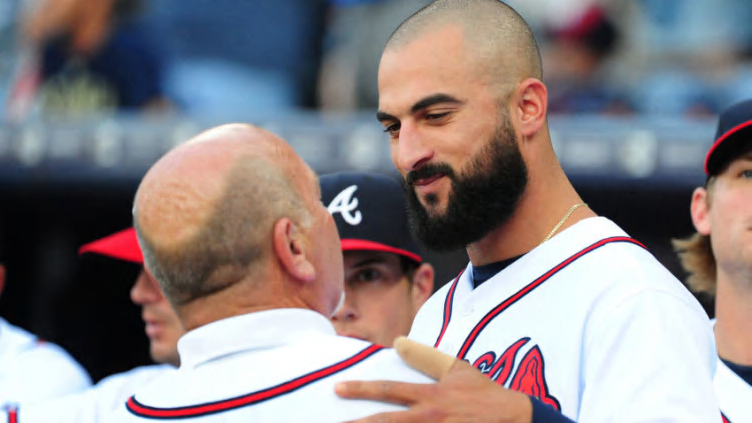
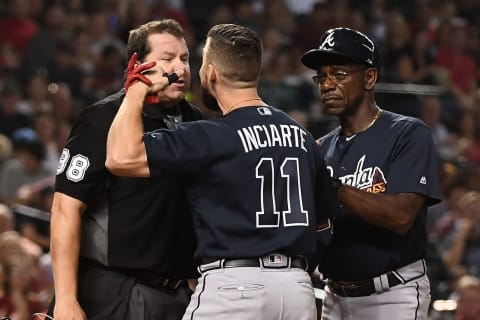
My list of the top ten outfielders in Atlanta Braves Franchise history brings together two players who played a hundred years apart.
Yesterday’s look at Atlanta Braves franchise outfielders reviewed players from near the same era. I begin this post with a Hall of Fame centerfielder, who joined the Atlanta Braves franchise at the end of the nineteenth century. He’s followed by a player lacking Hall of Fame credentials and depending on a completely different skillset.
The franchise’s long history meant I had to attempt to level the playing field across seven generations of players. I settled on plus stats as the way to do that. Plus stats like OPS+ tells us how well a player stacks up against the rest of the league during his era, with 100 as league average.
Using a Fangraphs custom player search by position, I created a table of the following plus stats.
- wOBA – if you care about determining how well a player contributes to run-scoring, wOBA is a more accurate representation of that contribution than OPS
- wRC+ – If you want a rate statistic for hitters that weights each offensive action and controls for league and park effects, wRC+ is for you.
- AVG+
- OBP+
- SLG+
In addition to plus stats, I considered sample-size in terms of games played, impact on the franchise, and contribution to the team’s success. I considered Hall of Fame membership and worthiness, and at times had to delve into minutia to make a choice.
Ranking players sounds simple. We believe we know what they accomplished, but I found the law of recency often clouds that evaluation. Some choices were obvious; others required hours of study before I made a decision
Throughout this post, I’ll reference biographies available for view on the SABR website, news articles mentioned in those biographies that may not be available online any longer, and books that may no longer be widely available. Bold type in a set of statistics indicates leading the league.
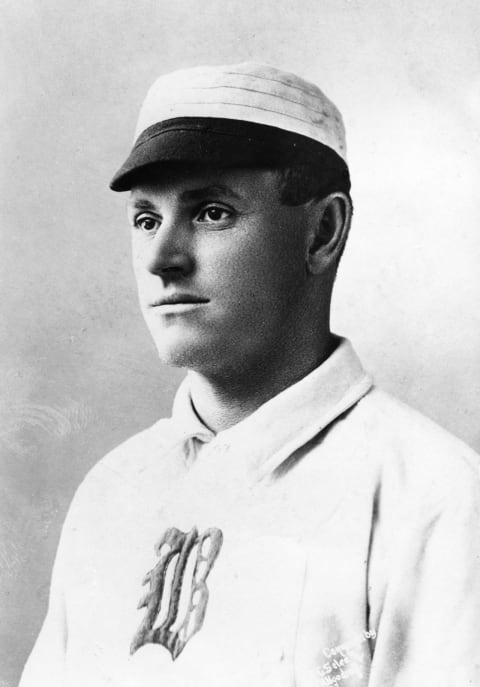
Number eight- Sliding Billy
| BA | OBP | SLG | OPS | AVG+ | OBP+ | SLG+ | wRC+ | wOBA | WAR | fWAR |
| .339 | .456 | .413 | .868 | 117 | 130 | 109 | 137 | .426 | 23.8 | 26.8 |
No one stole more bases or scored more runs in the 1800s, that William Robert ‘Billy’ Hamilton. Despite his many records and the way fans cheered his base-stealing, the sports pages wrote little about him at the time.
Bill James ranked Billy Hamilton as the ninth-best center fielder of all time in the 1999 edition of The New Historical Baseball Abstract, writing about his “anonymity” of a player that fans nicknamed Sliding Billy.
“Hamilton was completely invisible in the literature of the sport up to 1960 . . . and was not elected to the Hall of Fame until 1961. He left no legend behind him, no stories, no anecdotes . . .
The Quakers (Phillies) dominated the National League after acquiring Hamilton in 1890, led by their speedy centerfielder. In his five seasons in Philadelphia, Hamilton led the league in stolen bases four times, walks, runs, and OBP three times, batting average twice and posted a 1.014 OPS in 1893.
In 1895, the Phillies finished 15 games back in third place. Hamilton led the league in walks, runs, steals, and batted .389/.490/.495/.985. Fangraphs calls that a 6.9 fWAR, .471 wOBA, 157 wRC+ season.
The Phillies wanted Beaneaters third-baseman Billy Nash as their new manager and traded Hamilton to Boston to get him.
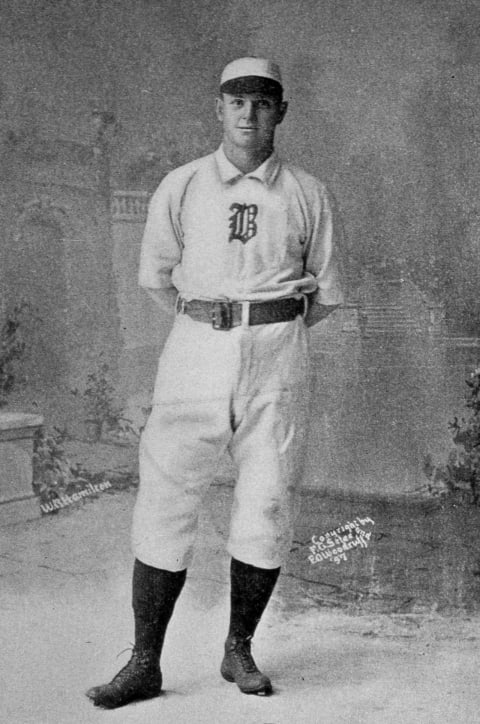
You’re my leadoff man
Beaneater manager Frank Selee made Hamilton his leadoff man and gave the speedster a permanent green light. In 1896, Hamilton played in all 131 games batting .366/.478/.468/.946, a 145 OPS+, had 192 hits, 110 walks.
In 1897, the Beaneaters added two pitchers to help Kid Nichols in the rotation, Hamilton batted .343/.461/.414/.875, scored 152 runs, walked 105 times, Bobby Lowe drove in 106, Hugh Duffy 129, Jimmy Collins 132, the Beaneaters won 93 games and the NL Pennant.
The club won the title again in 1898 with Hamilton batting .369/.480/.453/.933 at the top of the lineup, but age started to wear on the legs of Hamilton in 1899. Now 33, he managed only 84 games in 1899 after injuring his knee on a slide in May.
Hamilton returned to play a full 136 game season in 1900, batting .333/.449/.396/.845, but stole only 32 bases and for the first time since his rookie season of 1888, scored less than a run per game.
More from Braves History
- Atlanta Braves History: How the Red Stockings became the Braves
- Atlanta Braves 2022 Season Review: Jackson Stephens
- Travis d’Arnaud is an unsung hero of the Atlanta Braves
- Eight of the craziest injuries in Atlanta Braves franchise history
- Why the Atlanta Braves’ Dale Murphy shouldn’t be in the Hall of Fame
Unlike his namesake acquired by the Atlanta Braves in 2019 who found getting on base a challenge, Sliding Billy got on base at a .449 or better clip until 1901. In that final year, Hamilton’s average fell below .310 for the first time since coming to the NL, and his OPS, though still good enough for an OPS+ of 113, was his lowest since 1888.
Instead of hanging on for another season, Sliding Billy requested a release and hung up his spikes. He returned to the franchise in 1911 and spent two years as a scout. Today Hamilton ranks:
- third all-time with 914 stolen bases
- fourth all-time with a.455 SLG% ahead of Lou Gehrig at number five
- tied for seventh all-time with a .344 BA (Ted Williams), just.0003 behind Tris Speaker
- tied #14 with a .433 wOBA (John McGraw, Johnny Mize)
- #27 with 1697 runs scored
When Hamilton retired, he led baseball in walks, batting average, OBP, and stolen bases. He remains one of three players to average more than a run a game in his career. The mental giants on the veteran’s committee led by Kennesaw Mountain Landis gave him 2.6% of the vote in 1936, and the BBWA gave him 0.4% in 1942
Sliding Billy died on December 6, 1941, but it took the BBWAA 21 years to give him his rightful place in Cooperstown. On July 24, 1961, three of his children represented Sliding Billy at his induction into the Hall of Fame.
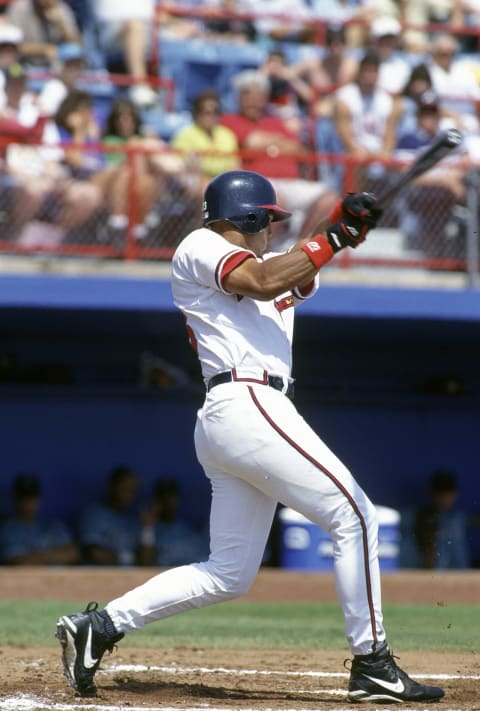
Number seven – Justice served
| BA | OBP | SLG | OPS | AVG+ | OBP+ | SLG+ | wRC+ | wOBA | WAR | fWAR |
| .275 | .374 | .499 | .873 | 103 | 112 | 123 | 133 | .381 | 24.3 | 25 |
The Atlanta Braves selected David Justice in the fourth round of the 1985 June draft and moved through the minors at a pace typical of the time. After a cup of coffee in 1989, he arrived in Atlanta to stay in May of 1990, splitting time between first base and right field.
The 1990 season saw Justice appear in 127 games, bat .282/.373/.535/.908,with a 143 OPS+ and 28 homers, good for a .400 wOBA, 145 wRC+, and 3.3 fWAR. He ran away with NL Rookie of the Year voting landing a 98% share to win the award. Justice also finished #24 in NL MVP voting
He started 1991 in the unenviable position of replacing an Atlanta Braves fan favorite Dale Murphy. After struggling in April, Justice turned it around quickly, with a scalding May that included five homers and a 1.079 OPS.
On June 19, the Braves’ right fielder was batting .304/.389/.530/.919, with 11 home runs and a league-leading 61 RBI, but a back injury pushed him to the DL on June 26. Justice returned on August 20 and picked up where he left off, smacking ten more homers, and driving in 36 runs.
Justice finished twelfth in MVP voting as the Braves headed to their first World Series since 1958. After going 5-25 with a homer against the Pirates, he had a 7-25 World Series with two homers as the Braves lost to the Twins.
The 1992 season began with Justice playing only eight games in April, and returning to league play while still trying to find his stroke in May. When the calendar turned to June, his bat woke up; from June through October 4, he batted .279/.385/.494/.970, hit 31 homers and drove in 61 runs.
Justice returned healthy for the 1993 season, hammered 40 homers, drove in 120 runs and posted a .571 OPS, and earning his first All-Star game nod. He finished third in NL MVP voting behind Barry Bonds and Lenny Dykstra and won his first Silver Slugger award, but had a forgettable postseason.
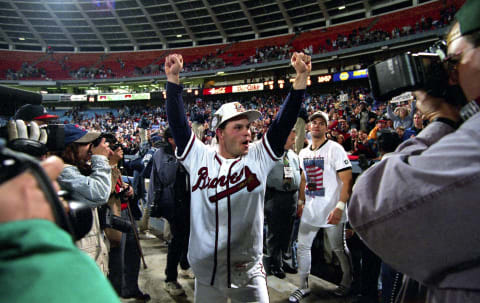
A great non-trade
In January 1994, the Atlanta Braves were looking for a closer and in discussions with the Royals for Jeff Montgomery. According to Max Rieper on SB Nation, in return, the Royals wanted Justice or Ron Gant and Mark Wohlers. The Braves wanted to substitute Ryan Klesko for Justice, but the Royals didn’t want the unproven player.
Justice was scorching the league with a .313/.427/.531 line and 19 homers when the strike ended play in 1994. Klesko appeared in 92 games, batted .278/.344/.563/.907, hit 17 homers, and Wohler appeared in 51 games with just four bad outings.
In 1993 the Royals’ righty Montgomery saved 45 games in 1993, with a 2.27 ERA, 1.008 WHIP, a 10.1 k/9 rate, and hitters batted .206/.263/.291/.554 against him.
In 1994 he saved 27 games in 32 opportunities, his ERA jumped to 4.03, his WHIP jumped climbed 1.00 to 1.410, and his K/9 dropped to 6.7
Bullet dodged.
The Atlanta Braves World Series season
When baseball returned in 1995, Justice remained a dependable piece in the lineup. From April 26 through June 1 he batted .278/.398/.500/.898, but hit only four homers then miss two weeks with an injury. He returned June 17 and finished the season 253/.365/.479/.844 with 24 homers and 78 RBI.
He struggled against the Rockies in the NLDS and the Reds in the NLCS. In the World Series, he batted .250/.400/.450/.850, walked five times, struck out once, and as I recall, hit a home run you can watch by clicking this link; Tony Pena’s reaction; is worth watching.
Justice played in one more Atlanta Braves season, but it lasted just 40 games. In the bottom of the second inning, he swung at a pitch from future Brave Denny Neagle, and separated his shoulder, ending his season.
On March 25, 1997, the Braves traded Justice and Marquis Grissom to the Indians for Kenny Lofton and Alan Embree.
On August 17, 2007, David Justice became the first member of the team that began The Streak inducted into the Atlanta Braves Hall of Fame.
That’s a wrap
It’s remarkable that a player with Billy Hamilton’s credentials took so long to earn his place in Cooperstown, it just also shows how relationships with the press and owners affected how much fans knew about him.
Thirty-five years passed between Hamilton’s retirement and the first Hall of Fame vote. Voting in the early days of the Hall was less effective than a Twitter poll for the best bagel. It took another 20 years or so to get voting better organized.
Next. If we wait too long the king won't be happy. dark
I think David Justice had one of the prettiest swings I’ve ever seen. Minus the injuries that cost him so many games and the strike, he might have ended his career with 450 homers and at least one MVP under his belt.
Part three coming soon.